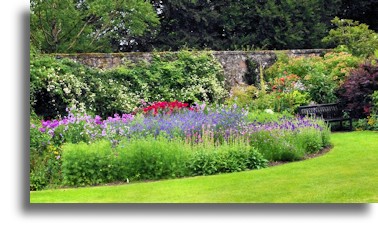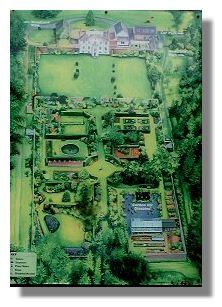
History
 Greenbank House and Gardens in Clarkston, about six miles from the centre of Glasgow, were established in 1763 by Robert Allason, one of the many Glasgow merchants. He was no stranger to the area - his forebears had farmed in the area for centuries. After making his fortune, particularly in trading with the American colonies, he bought a large part of Flenders Farm, the home of his ancestors.
Greenbank House and Gardens in Clarkston, about six miles from the centre of Glasgow, were established in 1763 by Robert Allason, one of the many Glasgow merchants. He was no stranger to the area - his forebears had farmed in the area for centuries. After making his fortune, particularly in trading with the American colonies, he bought a large part of Flenders Farm, the home of his ancestors.
The house had sixteen rooms plus separate barns and stables and from the outset there was a walled garden, mainly to grow fruit and vegetables for consumption by those lived and worked there. Allason got into financial difficulties at the time of the American War of Independence (though many of his fellow-merchants coped very well with the conflict, running contraband tobacco into Glasgow for sale in the UK and Europe).
The house passed through a number owners until it was bought by W P Blyth in 1962. With his wife, he began the ornamental planting which is such a joy today - until then it had been used largely to grow fruit and vegetables for the owners. In 1976, the Blyths gave Greenbank House, the 2.5 acres of walled garden and the 16 acres of the estate to the National Trust for Scotland so that everyone could enjoy the peace and quiet and the ever-changing flowers throughout the year.
250th Anniversary Celebration

The National Trust for Scotland celebrated the 250th anniversary of the building of Greenbank House itself during 2013. A lot of renovation work on the garden was carried out in anticipation of this anniversary and a large number of events took place during the year. In addition, a striking metal sculpture was erected representing a "Green Man" - a decoration referred to in works on architecture as "foliate heads or foliate masks". It is thought that the motif goes back to Pagan times and carvings of the Green Man may take many forms, naturalistic or decorative. The simplest depict a man's face peering out of dense foliage. Some may have leaves for hair, perhaps with a leafy beard. There is a Green Man carved high on the front wall of the 250-year-old Greenbank House and a local metal worker took this as the starting point for this Green Man metal sculpture to mark the anniversary.
Layout


One of the great attractions of Greenbank Garden is its layout. By the skilful use of hedging and tall plants it has been divided up into about a dozen different areas, each with its own character.
As you wander from one area to the next, different styles and a variety of flowers and trees meet the eye. And, as the seasons change, some of the flower beds are given a complete makeover. The parterre, illustrated below, is full of daffodils in the springtime but these are replaced later by the anthemis and senecio as in the illustration below.

Fountain
One of the delights of Greenbank Garden is that as you wander round the various elements of the layout, you can hear the sound of a fountain - sometimes close at hand, sometimes at a distance. Because of the hedges and division of the garden into smaller sections, it is a minor challenge to actually find your way to the where the water is falling from the fountain.
The statue which forms the fountain is named "Foam" and is a green, female water nymph. The fountain was created by Charles d'Orville Pilkington Jackson (1887-1973) for the Empire Exhibition in 1938. His family gave the fountain to the National Trust for Scotland in the 1980s and the pond was made for it at Greenbank. It has only left the garden once since then, to appear in the Glasgow Garden Festival in 1988. Pilkington Jackson also sculpted the impressive statue of Robert the Bruce at Bannockburn (which was recently renovated in anticipation of the celebration of the 700th anniversary of the battle next year.
The Flowers

In the National Trust tea-room adjoining the garden, there is a large encyclopaedia of plants to help visitors to identify flowers which they don't know - and it is well used! The garden has around 3,000 plants, though with the changing seasons, not all are on show at the one time. In addition to the more usual spring bulbs, apple and cherry blossom, astilbe, aubretia, deutzia, dicentra, saxifrages, hydrangeas, primulas, dahlias, roses, philadelphus, azalea, rhododendron, lythrum, crocosmia, phlox, cosmos, echinops, sedum, lavatera, monarda, helenium (pictured here) and sweet william, there are rodgersia pinnata superba, echevaria gibbiflora metallica and agrostemma (plant labels helped with some of those too!).
When the Blyths bequeathed Greenbank to the National Trust for Scotland they asked that it should be run as an educational/education garden. Much of the planting has been designed to be a source of inspiration to ordinary gardeners who can see not only flora which they can plant in their own plots at home but also layouts which can be adapted to smaller scale gardens.

Parkland In addition to the house and walled garden, visitors can wander around the 16 acres of woodland. These are at their best in the springtime when the rhododendrons and daffodils are in bloom.
The small herd of Highland cattle are a popular sight throughout the year, however. It is a sign of the times that most of the herds of these shaggy beasts are to be found nowadays on estates in the central Lowlands of Scotland - though it is also bred in the USA, particularly Wyoming.
YouTube Video of Greenbank Garden

In the late summer of 2013 I took a number of video clips of the gardens at Greenbank and transformed these into a video sequence lasting ten minutes on YouTube. See YouTube - Greenbank Garden
Opening Hours
Greenbank Gardens is off the main road from Clarkston to Newton Mearns and is well sign-posted. It is open every day from 9.30am to sunset but the tearoom and shop is only open each day from 11am to 5pm from 1 April to 31 October and 2-4pm at weekends from 1 November to 31 March.



